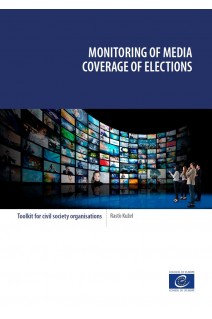Toolkit for civil society organisations.
During elections, media monitoring by civil society organisations provides benchmarks for judging the fairness of the election process, and gives professional, comprehensive and objective assessment of political diversity and balance in the news and current affairs coverage. The results of media monitoring can help to initiate and substantiate an open discussion about the objectivity and quality of the media reporting and to promote media compliance with international standards and good practices of fair, balanced and impartial media coverage of elections.
The aim of this Toolkit is to provide civil society organisations with detailed methodology of how to implement a monitoring project of media coverage of elections, containing description of its stages and activities, as well as practical step-by-step guidelines and tips with regard to monitoring of different types of media (TV, printed and online media, social media).
The publication contains tools and methods that can be applicable in any Council of Europe member state and adjusted according to the given context and research question to be answered, as well as presents media monitoring case studies from several countries.
ACKNOWLEDGEMENTS DIVISION OF ELECTIONS AND CIVIL SOCIETY (DG DEMOCRACY) INTRODUCTION – WHAT IS THE PURPOSE OF THIS TOOLKIT? WHO CAN USE IT AND HOW? SECTION 1 – ELECTION CAMPAIGNING IN THE 21ST CENTURY. NEW CHALLENGES IN MONITORING MEDIA COVERAGE OF ELECTIONS
Election campaigning in the 21st century
The changing media environment
New challenges in monitoring the media coverage of elections
SECTION 2 – INITIATING A MEDIA MONITORING PROJECT
Developing project goals
Purpose of the monitoring
Recruiting monitors
Human and financial resources
Developing a timeline
SECTION 3 – HOW TO MONITOR TELEVISION, PRINT AND ONLINE MEDIA
Analysing the legal and regulatory framework
Scope and type of monitoring
Deciding what outlets to monitor
Public broadcast media
Private broadcast media
Print and online media
Monitoring different types of programmes
Deciding what actors to monitor
Advantage of incumbency
Media analysis: what are we trying to determine?
Reporting
SECTION 4 – HOW TO MONITOR SOCIAL MEDIA
Scope of monitoring
Tools available for data collection and analysis
Analysing and choosing relevant data
Publishing reports: format and frequency
Data interpretation
SECTION 5 – HOW TO ENGAGE MONITORING ACTORS AND ENSURE SYNERGY BETWEEN STAKEHOLDERS AND THE SUSTAINABILITY OF MONITORING RESULTS SECTION 6 – MAKING AN IMPACT WITH MONITORING: HOW TO USE THE RESULTS TO ADVOCATE FOR IMPROVEMENTS AND CHANGES
Post-election follow-up
APPENDICES
Appendix 1 – Media monitoring matrix
Appendix 2 – Useful tips for a media monitoring project
Appendix 3 – Case study from Ukraine
Appendix 4 – Examples of social media monitoring projects









